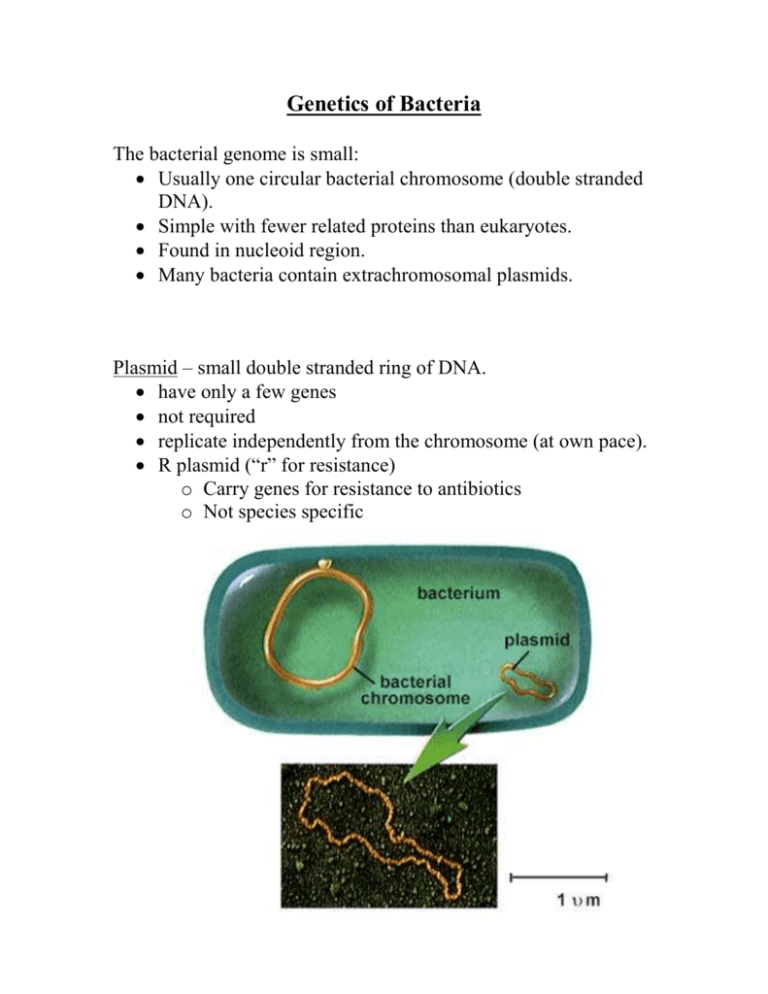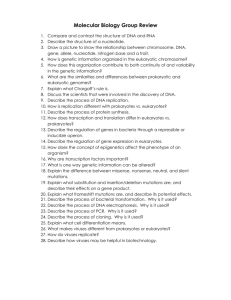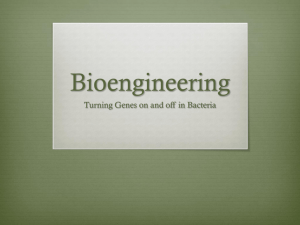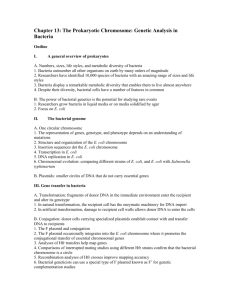Genetics of Bacteria
advertisement

Genetics of Bacteria The bacterial genome is small: Usually one circular bacterial chromosome (double stranded DNA). Simple with fewer related proteins than eukaryotes. Found in nucleoid region. Many bacteria contain extrachromosomal plasmids. Plasmid – small double stranded ring of DNA. have only a few genes not required replicate independently from the chromosome (at own pace). R plasmid (“r” for resistance) o Carry genes for resistance to antibiotics o Not species specific Most bacteria reproduce by binary fission: Asexual reproduction that results in 2 clones (genetically identical with the exception of rare mutations). Replication starts on a single place on the chromosome and moves in opposite directions until the forks meet. Under optimal conditions bacteria will divide every 20 minutes. There are 3 major sources for genetic variation in bacteria: 1. Transformation – bacteria takes up foreign DNA from the environment. o DNA is often in the form of a plasmid. o DNA can become part of the bacterial chromosome by recombination. o Bacteria can be artificially induced to take in DNA. o This is a method used to introduce genes of interest into bacteria. 2. Transduction – gene transfer from one bacteria to another using a phage as a vector. o vector- a vehicle used to transfer DNA into a cell. o Generalized transduction – random pieces of bacterial DNA is packaged into a viral particle by accident during the lytic cycle. o Specialized transduction – when a propahage carries an adjacent gene when moving from the lysogenic cycle to the lytic cycle. 3. Conjugation – the direct transfer of genetic material between cells (similar to sexual reproduction). o A DNA donatic cell extends “sex pili” (an appendage) and attaches to a receiving cell. o A cytoplasmic bridge is made and a plasmid is exchanged. o The presence of the “F plasmid” (F for fertility) allows the formation of sex pili. Cells with the F plasmid are called F+ Cells without the F plasmid are called F Conjugation is between F+ and F- cells. The Fwill become F+ if the F plasmid is exchanged. Control of gene expression in prokaryotes Genes can switch on and off under varying conditions Many of the same mechanisms for regulation already discussed still apply o activation and inhibition o feedback inhibition Many bacteria control their gene expression through operon units. o Operon – a cluster of adjacent genes with related function. o Structural gene – gene that codes for a polypeptide. o Operator – a segment of DNA that controls the operon. o Repressor – a protein that binds to the operator and stops mRNA transcription. o Activator – a protein that stimulates the transcription of mRNA by binding to the operator. o Regulatory genes – genes that code for the production of repressors. o Repressible operon – operons which have their transcription inhibited. o Inducible operon – operons which have their transcription stimulated. The Lac operon of E.coli is a widely studied operon.











